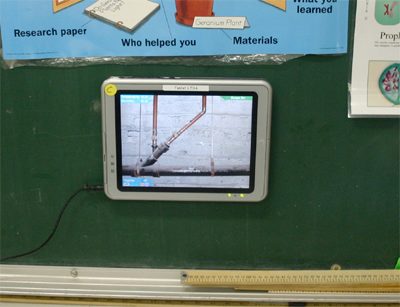WallCology: A Learner’s Interface to a Persistent Virtual Ecosystem
November 1st, 2007
Categories: Applications, Education, MS / PhD Thesis, Multimedia, Software

Authors
Uphoff, B. E.About
This thesis presents the motivations, inspirations, design and architecture of an ecology learning environment for middle school science classrooms. The application, WallCology, places a virtual ecosystem within the walls of a classroom, drawing from ubiquitous computing concepts. The system is designed to give learners easy access to affordances for the study of ecological phenomena as ecologists would in the field. Using a set of computers as portals into the virtual ecosystem, students study creatures with different morphologies and behaviors moving about on pipes and walls. These portals, called WallScopes, are linked together using a remote server which allows the creatures to move within the larger virtual space based on their own environmental preferences. A two month pilot study of WallCology in an urban middle school classroom comprised of species differentiation and population estimation units demonstrated the feasibility of this approach.
The interactions of Earth’s inhabitants have given rise to a wide variety of ecological principles and methods of study and many are not readily accessible for study in elementary school classrooms. As teachers strive to produce scientifically meaningful activities which promote ecology learning for their students, they are often required to work within the space of their classroom because of the logistical and financial constraints involved in taking a group of students into the field. Often teachers bring flora and fauna into the classroom for study but the inherent lack of control can make study difficult. Additionally the removal of such organisms from their natural habitat inhibits the learning of “in the field” ecology principles. WallCology seeks to provide a platform for studying many ecological principles by placing a controlled virtual ecosystem that is readily accessible for everyday use within the confines of elementary science classrooms.
Ecology in the field is widely observational and seeks to limit the impact by scientists on natural habitats. Additionally, ecologists can only view a sample of the overall system at any one time, thus science requires meticulous data collection as well as collaboration with other observers to gain an overall perspective. These are principles that are difficult to teach with textbooks and can be better taught though practice. The computers of WallCology offer only small samples of the overall space at observational “sites” and thus correlate directly to these principles.
WallCology is built on the embedded phenomenon framework (Moher, 2006) and extends many of its ideas. Previous embedded phenomena have mapped scientific phenomena to the interior of a classroom. WallCology modifies this idea slightly by mapping the phenomenon of an ecosystem to the unseen space between the walls of a classroom. This small distinction in setup lends well to the incorporation of multiple classrooms. Past embedded phenomena have been largely task based and directed at specific curricular goals. WallCology was initially conceived as a platform for teaching many ecological principles and its architecture has been designed for extension and code reuse. The initial implementation, which aimed at species differentiation and mobile population estimation, can be extended to include food webs, life cycles, evolution, and other ecological principles increasing the duration from weeks to months and possibly years of study by elementary learners.
Resources
Citation
Uphoff, B. E., WallCology: A Learner’s Interface to a Persistent Virtual Ecosystem, Thesis in partial fulfillment of the requirement for the degree of Master of Science in Computer Science, University of Illinois at Chicago, Chicago, IL, November 1st, 2007.